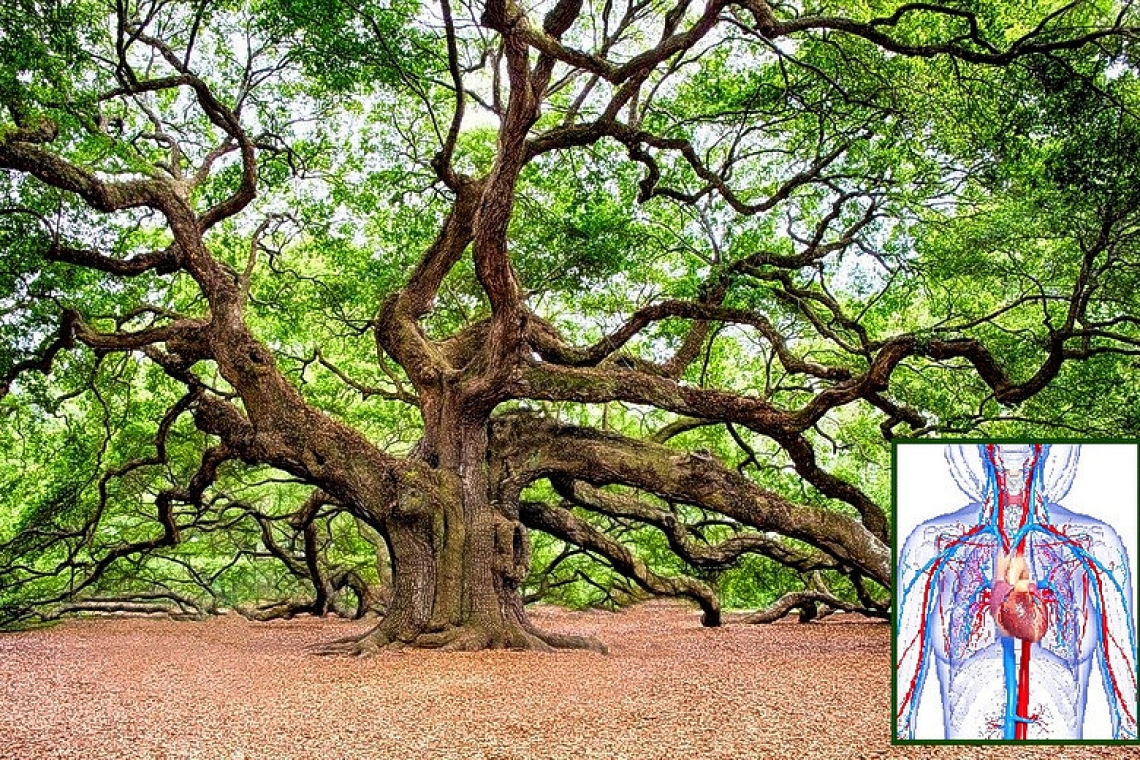Authors: Dr. Colin Michie, Paediatrician; and Denise Harford, nurse.
Whether you consider your ancient relatives, or a newborn infant, you are looking at celebrations of branching structures. A crucial breathing tree divides many times to reach tiny air sacs and has about 1500 miles of airway.
Large trunk-like arteries carry blood from our hearts through branching networks from our lungs to the vast, mesh of tiny blood vessels serving every tissue and cell with oxygen and nutrients.
Arterial trees are probably over 100,000 miles long in an adult. Between one and one and a half gallons of blood are pumped by our hearts each minute through this tree.
Every heartbeat sends a pulse along muscular arteries down to our toes. Blood returns more quietly to the heart through a lower pressure tree – this made of veins. Veins contain most of our circulating blood – this tree has wider branches, with more elastic lining. They are capacitance vessels and rely on nerve and muscle action in your legs to squeeze blood back to the heart.
Veins have small valves inside them to help with this – you may have found one or two of these showing as a small soft bump on your leg. Between the arteries and veins is another very large, mostly microscopic network of lymph vessels that circulate fluid around cell surfaces. These drain lymph towards the heart. They too need muscle activity to prevent fluid collection or oedema.
Veins tend to be near the surface of the skin and can look blue because of their connective tissue sleeves. The elegant vein tree is one we tend to overlook, with its burden of dark red blood.
Blood-letting from veins has been fashionable for treating many disorders since ancient times, whether with incisions or leeches. But consider how this tree keeps a fluid full of cells and proteins, moving at low pressure, sealing holes made in it by leeches, mosquitoes, thorns or trauma.
How to make clots to seal leaks when needed, but otherwise keep blood flowing is a careful balance. Small cell fragments called platelets, a set of proteins and blood vessel lining make up a linked clotting system that reduces friction in the vein tree.
If you do not have enough platelets, for instance, blood will leak out of small vessels at the slightest pressure, causing bruising or bleeding.
Aspirin can sometimes cause bruising by making platelets less likely to form clots. Smoking, diabetes and some oral contraceptives can have the opposite effect, making blood clotting more likely. Recently, it has been found that the COVID-19 virus can cause small clots to form in a patient’s veins.
Varicose veins can be found in at least a quarter of adult legs over 50 years of age. They are more common in taller or obese folk, which gives a clue – they grow with increased pressure. Leaking through leg vein valves causes longer veins to twist and for blood flow to slow down.
Some women will develop them during pregnancy.
Varicose veins may ache or itch. They delay drainage of the meshwork of small vessels around the feet and ankles – skin can sometimes ulcerate.
Other types of varicose veins include haemorrhoids or piles, and varicoceles in the testicles – that might link to sexual dysfunction. Less common are varicose veins in the oesophagus or stomach, caused by a hard, cirrhosed liver.
Treatments for varicose veins are many and varied. But, as always, it is important to look at why these varicosities are there, and to remove the cause. Then improve the flow of blood in the vein tree.
Physical activity and a healthy body weight will minimise varicosities. Many rubbing oils and creams are proposed to help varicose veins on the legs, and surgeons have some novel surgical techniques to solve leaks in leg valves.
But never forget the humble compression stockings. Almost all of us, from desk pilots to professional athletes, will benefit from compression stockings. They are not just for hospitalised patients!
Squeezing from the outside by tough skin is how a giraffe or ostrich keeps veins in good shape. Stockings need to squeeze your leg. Very few strategies cause varicose veins to disappear forever, but they will often improve symptoms and reduce complications.
Damaged veins or sluggish circulation can cause thrombosis: the formation of clots. Clots are really dangerous. They can lead to skin ulcers or they can move in the vein tree to the heart or lodge in the lung – a pulmonary embolus.
These problems can be life-threatening. Treatment usually starts with daily medications to thin the blood – anticoagulation. This works well and should improve the health of the vein tree and the clotting system.
So, on reflection, how is your vein tree doing today?







